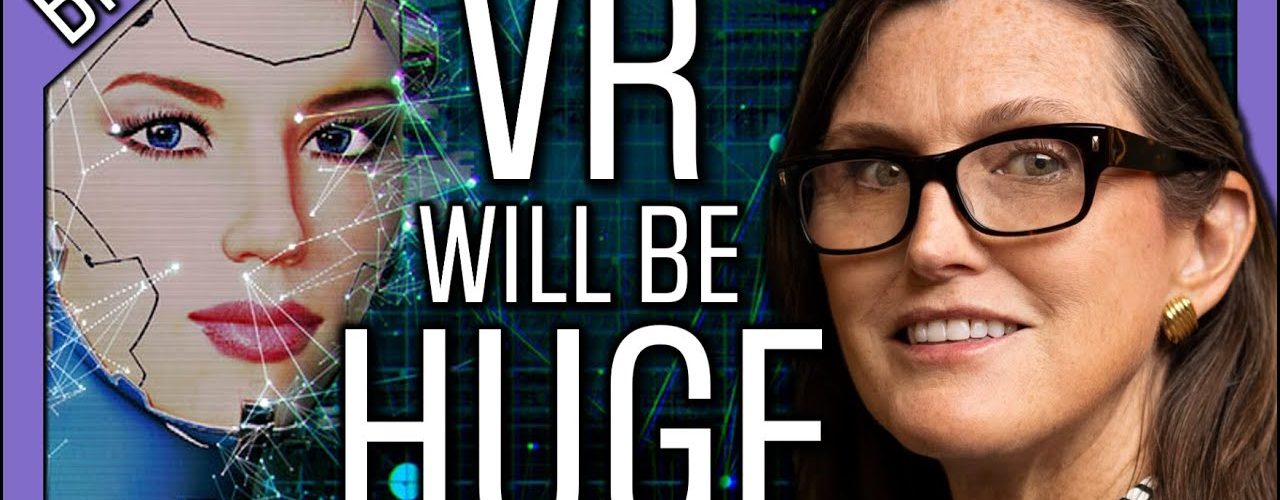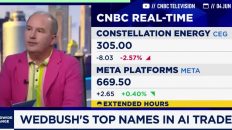Mentioned in Video:
- 🎬 EXCLUSIVE: VR is Changing the World | How Vection Technologies (VR1) is Disrupting Design: https://www.youtube.com/watch?v=moB3fch_eOc
- Vection Technologies Investor Presentation (direct PDF download): https://static1.squarespace.com/static/5ee07b7ffb7184427b1f3cf9/t/5f9651f266dc2c250811f05c/1603686943071/02274282.pdf
- Vection Technologies Website: https://www.vection.com.au/
- Vection Technologies on YouTube: https://www.youtube.com/channel/UCW5yj-h4n_IsY7dJ1G7y_GA
- @Mindesk on YouTube: https://www.youtube.com/c/Mindesk
- Support the channel and get extra member-only benefits by joining us on Patreon: https://www.patreon.com/tickersymbolyou
The best VR stocks in 2021 may surprise you. #ARKInvest‘s #BigIdeas2021 includes VR/AR technologies (think VUZI stock, FB stock, MSFT stock for Hololens, etc.) which are in ARKW, Cathie Wood's fund themed around the next generation of internet applications. Likewise, VR stocks and virtual worlds could also become core to positions in ARKK, ARKG, ARKF, ARKQ, and ARKX as Virtual Worlds change the way we learn, collaborate, and design the future.
Video Transcript:
[00:00:00.000]
The world is changing. New innovations are being delivered faster than ever before. The lines between the physical world and the digital ones are boring. So too are the lines between advanced technologies. Where one innovation ends and another begins is not always so obvious. Where one world ends and the next begins may not be so obvious either. The most disruptive companies are no longer delivering single products or services. They are delivering change. And one day where technology ends and where we begin may not be so obvious either.
[00:00:37.290]
Digital worlds are not just about gaming or travel. They are going to change the face of engineering. They will open new doors in health care and medicine. Oh, jeez. Digital worlds will change not only the way we architect the physical one, but the tools we use, where we design it from, who we design it with, and maybe even the concept of design itself. So I'd like to talk about ARK Invest's vision for virtual worlds as well as where I agree and disagree with that vision. Then we'll tie everything back to the stock market and we'll look at some of ARK Invest's biggest positions in the space, as well as some highlights from an exclusive interview I had with one publicly traded company focused on making this vision a reality. A real reality, not a virtual reality.
[00:01:23.580]
Wait. So let's take a step back into the real world and start with a more near-term vision of virtual worlds and some of the current challenges with implementing them. Here's Cathie Wood, explaining virtual worlds as one of ARK Invest's new big ideas for 2021. During a recent interview on ETF Trends with Tom Lydon.
[00:01:42.120]
Virtual worlds, this has been a long time evolving. You remember the Google glasses, premature. The technology was not ready and the costs were not low enough. And believe it or not, that is still the case. But we are beginning to see breakthroughs now that could really impact the gaming market first. So you can see here the gaming market, and this is the gaming market
[00:02:15.910]
as you and I know it.
[00:02:16.990]
Which includes both the premium $60 games plus in-game purchases. You can see that we expect a 16% compound annual rate of growth during the next five years. Now you'll see that's coming much more from in-game purchases. So that world continues to transform. What's been really interesting about following the gaming sector over the last 25 years is that every time a new technology has evolved, the gaming sector has seen incremental growth. That is unlike video and music. With each new technology, they got hit. Gaming is the only area we've seen that has been able to migrate from one technology to another and the space gets bigger.
[00:03:03.850]
We believe this is about to happen once again with artificial reality and virtual reality. So we are looking at a 59% compound annual rate of growth. We do think that technology is almost there we know that Facebook, with Oculus, has been seeing some good success. It's been sold out of its latest model. We believe COVID-19 helped to accelerate that as it accelerated so much innovation.
[00:03:32.920]
So pay attention to this space.
[00:03:34.540]
It could be very exciting.
[00:03:35.680]
Hello, human. Welcome to an accurate simulation of office worker.
[00:03:40.210]
In my experience, when people think of virtual worlds, this is what comes to mind. From the get go, the technical challenges are painfully clear. Your hands are actually hand shaped boxes. The graphics are not immersive, to say the least. And the physics engine is nowhere near reality. As an investor, footage like this certainly doesn't make me feel like we're on the cusp of a huge breakthrough in, well, anything. Slowly, but surely, though, things have gotten better.
[00:04:07.900]
Okay, but that's my thumb. That's my pinky.
[00:04:11.310]
Okay.
[00:04:12.300]
Can I write my name? S-E-A-N. Yeah, I did it.
[00:04:20.600]
And you guys are about to see something really special. Oh, gosh. It doesn't grab things properly. Right.
[00:04:26.920]
Okay.
[00:04:28.780]
Intricate, intricate. Here we go.
[00:04:34.580]
Come on.
[00:04:35.910]
This should be much easier than it has ever been before.
[00:04:39.210]
He's right. It should be getting easier. That's exactly where the state of the art of virtual worlds has slowly but surely been improving. Graphics are becoming more realistic. Vr physics are becoming more lifelike. The controls are getting better, and of course, now you can play with friends.
[00:04:56.600]
Surgery, apologize.
[00:04:58.040]
I don't need to hire anymore.
[00:05:00.000]
What does Bob need before we just start? Like hacking on surgery?
[00:05:04.960]
This game called Surgeon Simulator Two, came out in August of 2020. It's silly and cartoony and fun because it's first and foremost a game. And here's where I respectfully disagree with ARK Invest. I think that breakthroughs in VR aren't affecting gaming first. Check out what happens when a team tries to build a real surgeon simulator in this clip from Ghost Productions. Showing the first public demonstration of rate VRS surgical simulator.
[00:05:31.990]
I'm going to show you something that we built a great demo on this new Oculus Rift S system. This is our new system viewer, show you our demo. So without any further ado, I'm going to go into our virtual space.
[00:05:49.220]
So,
[00:05:52.220]
now you'll see me in virtual space. You can see here's my head and I have hands fully functional hands. I can use all my appendages and see that I can also use them to grab these tools over here like this pin driver and pull triggers. Okay, so this is our surgical environment you can see here. The first thing I'm going to do is put the knee into 90 degrees flexion, so I'll grab the ankle here, given a highlight to help me see the goal where I want to put this leg.
[00:06:32.640]
Okay, there we go. All right. Now we have it 90 degrees of flesh. I'm gonna select a scalpel from the mail stand.
[00:06:40.160]
I see a video in it.
[00:06:42.000]
Now I can see that there's a highlight to help me know where to start my incision. It's also lined on the midline of the patella to tell me where I should make this incision.
[00:06:52.170]
The first time I saw this clip, I had to shut my eyes right as the scalpel touched the knee. Don't judge me. But seriously, look at how immersive this is. It feels like you're watching a real surgery, which is exactly the point. This is a real surgeon simulator. The graphics, the controls, and the physics engine are all refined to the point where this would add real value to doctors, nurses, medical students, and anyone else depending on the specific simulation. Medical practitioners can log into a virtual operating room and lower the risk of a real-life operation by trying and comparing a few procedures before deciding on their approach to the real thing.
[00:07:29.580]
They can work through potential challenges that might arise during surgery and test out different contingency plans. Heck, they can even bring the patient into this virtual operating space beforehand, answer questions and help them feel at ease. In fact, that's already starting to happen in brain surgery, which has always been very tough to visualize since most medical imaging techniques result in two dimensional slices of the brain. So let's take a look at how virtual reality is starting to empower brain surgeons. Not just for surgical planning, but also in how they can relate to their patients,
[00:08:01.770]
in this mini-documentary by Freethink titled Bringing Virtual Reality to Brain Surgery.
[00:08:07.430]
It'S difficult to talk to patients about brain surgery because it's very abstract. We're combining delivering difficult news about a scary diagnosis with the additional fear of not knowing what to expect and not being able to understand what it is I'm explaining to them. When we show them the model, when they fly inside their own brain, they can see the structures, they can see the tumor, they can see the aneurysm.
[00:08:29.570]
Patients are looking for some hope. They're looking for a way to understand what's happening. What's made brain surgery historically pretty challenging is surgeons have to look at two dimensional imaging and then, in their mind's eye, create a three dimensional map of how they might approach the operation. We thought, you know what? We can intervene here and we can take MRI and CT scans and fuse them together in our software to create a virtual reconstruction, change the practice of medicine for the benefit of the family, the surgeon and the institution.
[00:09:01.440]
It is that person's anatomy VRlized. Before surgical theater,
[00:09:07.160]
preparing for surgery was literally me sitting over a cup of coffee kind of thinking, okay, I'm going to do this. And then I remember that the optic nerve is here. But those preparations were a kind of ad lib. Now, with 360 degree 3D reconstructions, we're able to be inside that environment, which is as close to brain surgery as we can actually get without being there in the operating room. The advantage that the virtual planning and rehearsal brings to our readiness for surgery is the ability to simulate multiple different approaches. In a real patient,
[00:09:40.240]
we don't get to try that more than once. We only get one shot at it. In the virtual model, we can do two plans, three plans, five plans and see which one is the best for the individual patient.
[00:09:50.420]
In my opinion, brain surgery is a field where the bar for technology is incredibly high. The fact that there are virtual reality solutions that can clear this high bar shows me as an investor that the technology is much more capable and mature than we realize. And if we agree that VR technology is worthy of literal brain surgery, the next obvious question is, where else could it be useful? Speaking of useful, if you're finding the research so far and the related stock picks coming up useful, you can invest in the channel that invest in you by liking this video and subscribing.
[00:10:23.910]
So let's talk about the total addressable market for this mind blowing technology, starting with our actual minds. Here's another quick clip from Free Think titled Conquering Fear with Virtual Reality Exposure Therapy. Within kind of ABIAL therapy,
[00:10:39.240]
there is a technique called exposure therapy, and exposure therapy is the idea of flooding someone with the thing that causes them distress. So a really simple example could be if you're afraid to drive or couldn't get behind the wheel. So this is the Limbix head cell. Once that therapist knows that you're ready and comfortable to do this exposure, the therapist might start you off on a quiet street and so you're in your virtual reality headset as a patient and as the therapist next to me as I'm going through this as a patient all the while sees what I see in VR on their tablet and on that tablet, they can choose that quiet street.
[00:11:17.120]
They can also choose a busy road, like a highway or a tunnel or something much more anxiety can do to like break. And so the therapist will slowly but surely gradually expose you to more and more stressful environments. And while I'm viewing these and going through that, the therapist is also teaching me coping techniques to be more comfortable with what I'm doing and things that I can apply to my own life when I'm actually in the car afterwards.
[00:11:43.450]
Exposure therapy can be useful for treating PTSD and debilitating phobias. There's a whole new industry coming online here called Prescription Digital Therapeutics, and the FDA is beginning to evaluate apps the same way they evaluate drugs to make sure that the contents and the amount of exposure are safe for the patient. Imagine having access to many different mental health tools, services, and experts simply by putting on your VR headset. Medicine is just the beginning. Imagine having access to any tools, services, or experts from any industry simply by putting on that same VR headset.
[00:12:20.100]
Virtual worlds could be the culmination of the cell phone, the computer and the Internet, all three of which have radically transformed our lives. The merging of these different virtual worlds is inevitable. Just like having multiple browser tabs open at once or multiple apps working in the background of your phone. ARK invest even calls out this combined virtual world or the Metaverse on the cover slide for their virtual worlds as a big idea. So, let's talk about the publicly traded companies making this a reality, virtual or otherwise.
[00:12:52.350]
I recently had the privilege of interviewing Gabriele Sorento, director at Vection Technologies, ticker symbol VR1 on the ASX. Vection believes that virtual reality can be used in almost every industry and in almost every part of the value chain, from design and engineering to manufacturing to employee training, marketing and sales, and even long-term industrial maintenance. One special thing about Vection is that they're building a two-way link between collaborative virtual worlds and specialized industry-specific software.
[00:13:22.450]
Right in one click is possible to jump directly from the original CAD model into the augmented reality and make a reality. And it's possible now to change in real time. To get this result and then stopping on a moment. We basically built a technology that for the first time is able to activate a bi-directional light link between the virtual reality headset and the professional CAD software.
[00:13:55.210]
Think about what this means. You no longer need to know CAD to interface with CAD, you can just manipulate a model in a virtual world, and the CAD model will update accordingly. A designer can focus on design instead of keeping up to date with specific software packages, and we're just getting started. Let's add multiplayer.
[00:14:13.650]
We've been exploring ways to collaborate remotely, so we made this platform multiplier. So in the multiplayer session, now you're not only connected to the original CAD software, but you're also connected with your peers so you can see each other as avatars. Discuss as like you were in a console, but also having access to the full 3D model immersively, which enables interacting with the model, living nodes, changing parts like. Is like being this like virtual workshop where you're actually handling the bike without having the bike to even exist.
[00:15:05.160]
Yeah, this is incredible.
[00:15:07.180]
Multiple people collaborating in a virtual workshop handling the bike without the bike having to even exist and not having to be experts in Solidworks to make a meaningful contribution to this complex model. In the future, teams may no longer need access to expensive industrial software, certifications and trainings to bring their vision to life. And speaking of training and teams, imagine being able to recreate complex industrial zones and digitize the trainings. Teams on an oil rig can become acquainted with the layout and get trained up on emergency protocols before ever setting foot on the rig itself.
[00:15:43.950]
And it's not just complex reusable training scenarios. Think about doctors or architects or any professional being able to leave notes and comments right in the model to help instruct or train or keep things moving asynchronously as people working remotely around the world log into the model at different times.
[00:16:03.250]
Another very important way to interact is the possibility to create annotation live. So let's say, for example, that you won't tell me to move this chair a little right. You can just draw an arrow with your hands and leave notes like, right.
[00:16:25.200]
So I assume there's way more to it than that. But what you're actually kind of describing is this ability to comment in 3D space, obviously commenting code, right, people comment their models all the time, but you're showing like literal comments next to different pieces in this model, as opposed to just having a piece of CAD software with like, a comment on one thing, right? Yes.
[00:16:49.790]
And this is much more intuitive and past. Then working with 3D and can democratize this technology, even extending to people that are not like exactly expert at that.
[00:17:04.570]
I'd like to thank Vection Technologies ticker Symbol VR1 on the ASX for showing us that collaborative virtual worlds will be a new type of communication platform, not just between people, but between different software packages as well. I'll drop a link to my full interview with Gabriele Sorento on Ticker Symbol Live in the top right and in the description below. Now, let's talk about some of ARK Invest's biggest holdings for what is clearly a very big idea, starting with the hardware on the augmented reality side that we have Vuzix,
[00:17:36.520]
ticker symbol VUZI, a company focused on the next generation of smart glasses for consumers and for industrial applications. ARK Invest holds just under $60 million of Vuzix in ARKQ, ARK Invest's fund themed around the industrial revolution. Microsoft, ticker symbol MSFT also has a product line called the Microsoft Hololens in the augmented reality space. In the virtual reality space, Facebook ticker symbol FB owns the Oculus Rift, which requires a computer, and the Oculus Quest, which is an all-in-one VR solution. ARK Invest currently holds almost $100 million in Facebook stock in ARKF, their fun themed around financial technology.
[00:18:18.620]
But Facebook has been in ARKW, their fun themed around next generation Internet applications in the past. And we all know that Facebook as a company has a lot of big business units in many different markets.
[00:18:29.690]
I died already.
[00:18:30.950]
Okay.
[00:18:31.230]
I can do better.
[00:18:31.920]
With your left hand. Reach out and then squeeze.
[00:18:34.350]
Yeah.
[00:18:34.970]
What am I doing? Am I for?
[00:18:37.080]
Okay.
[00:18:37.560]
I apparently cut them in half.
[00:18:39.070]
Boeing uses VR to train maintenance workers on procedures for different commercial and military aircraft.
[00:18:45.160]
Yeah, there's multiple modules you can use in the virtual reality world, including military and commercial applications. The engineering electronic it's for multiple disciplines. The engineering engine work, electronics, simple pilot training as well.
[00:19:03.900]
Boeing, ticker symbol BA sits in the top ten positions of ARKX, ARK Invest's newest fund themed around space exploration. While Boeing might not make the hardware or software themselves, they have an important role in developing these industry specific training and testing modules, for the software. Unity Software is a platform for creating interactive, real time content in 2D, 3D, and of course, VR.
[00:19:29.740]
Runnin' is an interactive retro future dance party. You're inside this record store, you get these magic glow sticks and your dance energy brings the piece to life.
[00:19:39.720]
Unity Software is used in gaming, film, automotive, architecture, engineering, construction, and the list goes on and on. Unity Software is ticker symbol u and ARK Invest holds almost $800 million in it across ARKK, ARKW and ARKQ, making it their 14th biggest position overall. And that's the point. Virtual worlds are a disruptive innovation that will cut across many of ARK Invest's themes as well as market sectors, geographies and even software packages like we saw earlier. And, because virtual worlds are primarily software-driven, we might be using them to play, work, create and travel together sooner than we think.
[00:20:34.420]
This is Ticker Symbol: you. My name is Alex reminding you that the best investment you can make is in you.
If you want to comment on this, please do so on the YouTube Video Here














